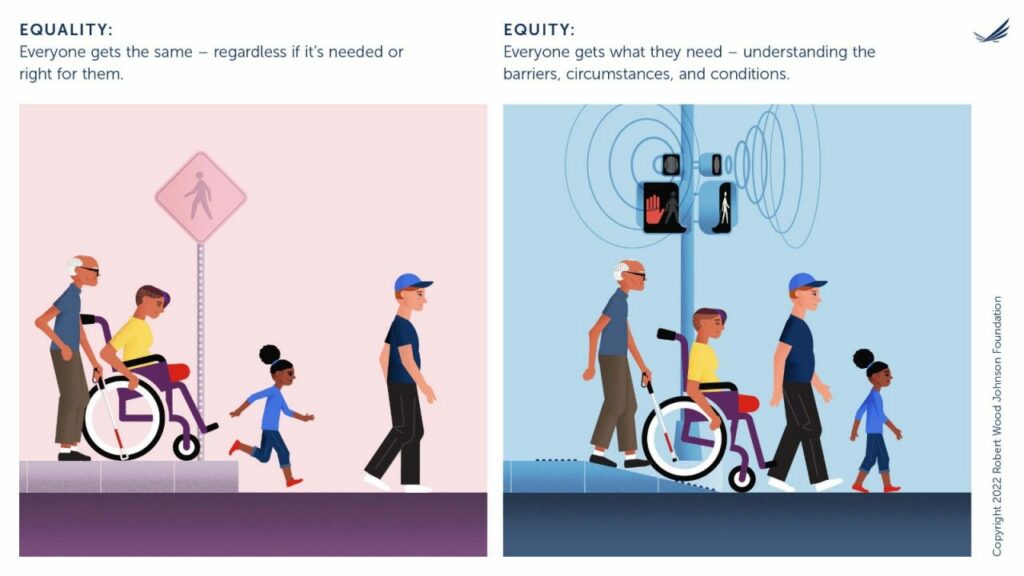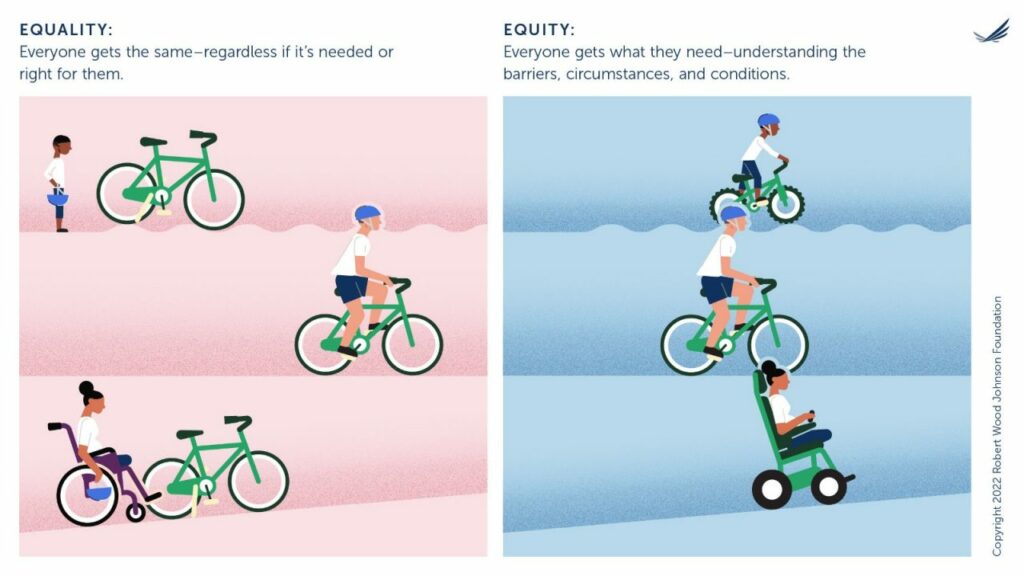Equity
Equity in SRTS means that every student is able to safely, comfortably, and conveniently walk and bike to school, regardless of race, cultural identity, tribal affiliation, immigrant or refugee status, language, gender or sexual identity, income, religion, and whether or not a student receives special education, has a physical or mental disability, or is homeless or highly mobile. An equity approach requires working with local partners to tailor programs and allocate resources to meet the unique needs of the community.
Priority populations include individuals, groups, and communities who are more likely to rely on walking, biking, or transit for transportation; are more vulnerable to unsafe traffic conditions; or have suffered historic disinvestment in safe, comfortable, walking and biking infrastructure.


Equity recognizes that different people have different barriers to living healthy, fulfilled lives. In order to allow people to get to the same outcome, we need to understand the different barriers and opportunities that affect different groups, and craft our policies, programs, and overall approaches with those various challenges and needs in mind.
Equity is often confused with equality, when in fact they have different meanings.
Equality assumes that all needs are the same. The result is that every community gets the exact same resources without regard to individual differences. Equality works only in circumstances where everyone starts from the same place and needs the same things.
Equity allows resources to be provided on the basis of need. Communities disproportionately impacted by safety, health or transportation access inequities are provided appropriate resources to address their individual needs. Therefore, resource allocation may differ between communities. While often used interchangeably with equality, equity involves a variety of strategies aimed at the fair – but not necessarily equal – provision of resources.
Why Equity Matters
Children from lower-income families are twice as likely to walk to school as children from higher-income families but typically face greater personal and traffic safety risks on their route to school.
Safe Routes to School programs increase physical activity and can improve student attendance, both of which are linked with higher academic achievement.

Infographic from www.activelivingresearch.org
Incorporating Equity into Safe Routes to School

Although all of the 6 Es should be implemented in conjunction with one another, equity is unique in that it can be applied to each of the other 5 Es.
- Evaluation of demographic and safety data can be used to identify the schools with the most need.
- Engagement should focus on meaningfully engaging with priority populations in the community to understand barriers and address relevant needs.
- Education materials should be provided in multiple languages for students to share with their families. Classroom activities should enable students of all abilities to participate and be culturally relevant.
- Encouragement activities should allow all students to participate. Faith-based organizations, neighborhood coalitions and housing groups may have the community knowledge and human resources to inform projects and help organize and support walking school buses and corner captain programs.
- Engineering treatments can make it safer to walk and bike to school by creating new and improved pedestrian and bicycle infrastructure in neighborhoods without them.
Resources on Equity in Transportation and Safe Routes to School
The following resources address transportation equity and provide strategies to ensure equity is considered in all elements of a Safe Routes to School program.
- Income Disparities in Street Features that Encourage Walking, Bridging the Gap
- Fighting For Equitable Transportation: Why It Matters
- At the Intersection of Active Transportation and Equity
- Transportation Health Equity Principles
- Evaluating Transportation Equity Guidance For Incorporating Distributional Impacts in Transportation Planning
- Implementing Safe Routes to School in Low-Income Schools and Communities: A Resource Guide for Volunteers and Professionals